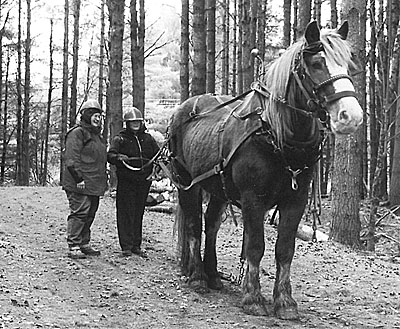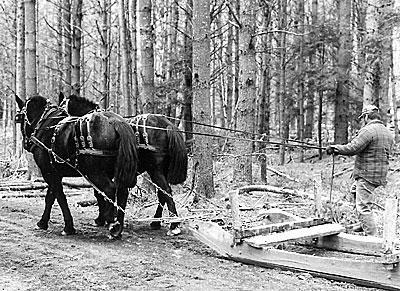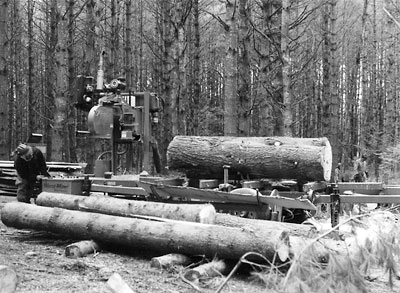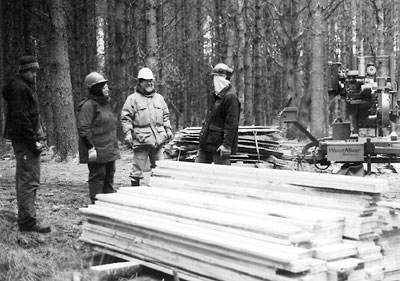 |
| Belgian gelding Nick is a patient teacher at MOFGA’s Low-Impact Forestry Workshop. Nan Brucker photo. |
MOFGA’s Woodlot Plan
By Nan Brucker
The woods are full of horses. A team of Suffolks pulls up to the landing with a load of logs, as a team of Percherons leaves with an empty scoot. Soft bells announce the arrival of a single Belgian, twitching out another log to be bucked into 8-foot lengths and forwarded to the pulp yard. In moments when the chainsaws fall silent, leaving only the sound of bells and hooves and the calls of teamsters, this could be a forest scene from a hundred years ago.
It’s not: It’s the annual Low-Impact Forestry (LIF) workshop in Unity, Maine. Held each year for five years now, it’s organized by a group of dedicated, experienced teamsters and sponsored by the Maine Organic Farmers and Gardeners Association at MOFGA’s Common Ground Education Center in Unity, Maine, which includes a woodlot.
Attendees range from novice teamsters who want to learn to work their horses in the woods to folks who’ve never held a pair of lines before but are about to get the chance. Over the next two days, we’ll work with experienced teamsters who will give us help with our technique, our gear and our relationships with our horses.
 |
| Pete Stratton heads into the woods with Percheron mares Misty and Princess pulling a scoot. Nan Brucker photo. |
By the time we show up early one November Friday morning, the old hands have already been in the woods for two days, in some tough conditions. Previous years have seen snow, but this year the ground is clear and the weather is windy and cold.
Before the workshop starts, the production crew has gone in with forester Barrie Brusila to mark trees, construct brows and trails, set up a portable saw mill and begin felling. We’ll be harvesting sawlogs and pulpwood, removing low-quality trees to improve the long-term health of the stand, and using horses so that the soil is disturbed as little as possible. The sawlogs will be milled on site to provide lumber for a new livestock barn for MOFGA’s Common Ground Education Center. The pulpwood brings cash to buy what can’t be produced on site.
About 30 of us gather for breakfast and introductions in the Exhibition Hall. A MOFGA event always features plenty of good, locally grown, organic food, and, like the lumber camps of old, this workshop will be fueled by the efforts of a talented team of hardworking cooks.
The plan is to have participants meet the old hands, review harnessing and equipment, try driving a single or a team out in the field, then move to the woodlot when ready. Discussions will be held along the way about basic driving skills and safety, how to build a woods scoot (a kind of sled), twitching with a single horse, driving a team with a scoot, how to use a horse-drawn logging arch, and how to lay out woods roads.
 |
| Sawyer Nick Zanstra prepares to saw a log on his portable Wood-Mizer sawmill. |
Soon, more than a dozen horses are in the woods, in teams and singles. Teamster Brad Johnson starts single twitching logs with the Belgian mare Sal that he and Mark Albee brought, and soon has a gaggle of followers, learning to set chains and taking turns driving.
Teamster Pete Stratton has Percheron mares Misty and Princess pulling a scoot, and Donny Webb alternates his Percheron geldings Pete and Bob and his Belgian mares Molly and Pearl on a scoot. Neal McNaughten has Nick and Belle twitching single, so more newcomers get to try their hands.
Adam Henry’s Percheron mare Maggie twitches wood out so quickly that she keeps several other teamsters busy forwarding logs down to a brow for the scoots. Jon Ellsworth works his Suffolk team, and Don Nickerson, with another team, scoots logs and offers plans and advice on scoot building, often at the same time. Long-time horseman Paul Birdsall hasn’t brought a team this day, but has plenty of knowledge to contribute.
Meanwhile, Peter Haggerty, who puts in hours organizing this event every year, is moving from group to group, matching people who have questions with teamsters who have answers. He makes sure everyone gets what he or she came for.
 |
| The finished product is ready for a MOFGA building project. Nan Brucker photo. |
Steady and deliberate, horses and teamsters move the wood from where it’s been felled out to trails, then to brows and onto scoots. (Brows are raised areas beside a trail that let teamsters drop single logs on the uphill side, then roll the logs down onto a waiting scoot (sled) below, without having to pick the logs up to load them.) From there it goes to the mill or to the pulp yard. The theme in 2003 was “from stump to stick,” and a Wood-Mizer portable sawmill was set up right in the woodlot by Vermont sawyer Nick Zanstra. Horses get used to pulling logs up next to the buzzing mill and standing quietly while logs are unloaded. Other teams pull 8-foot lengths out of the woodlot to the pulp yard.
Safety is a constant issue, because the wind is strong and cutters keep busy bringing down any dead trees. The old hands watch the treetops, ready to call everybody out if the wind gets too strong, and every cutter carries a first-aid kit. Horses new to the woodlot get used to the sound of chainsaws and the commotion of falling trees. Beginning teamsters get used to driving horses while keeping their own feet out from under logs and scoots, not tripping over tree roots and not driving right under a felling operation.
At the landings, pulp hooks, peaveys and picaroons fly to get the wood on and off the scoots, while teamsters swap opinions on what equipment they like best and why. One fellow offers a new pulp hook for use because he’s got a logging job coming up and doesn’t want to show up with too-shiny equipment.
At midmorning, a pickup truck horn announces tea break. The tailgate of this modern-day chuckwagon goes down, and the cooks dish out muffins, biscuits, cookies, bread and butter, apples, cheese, tea, cider, coffee and anything else they can think of to keep the crews thawed out and stoked up. Some of the apples find their way to the four-footed members of the crew.
Work continues until midday dinner and a break for the horses, then everyone is back to the woodlot, although the wind is blowing whitecaps in the horses’ water buckets. By 3:30 the cold is getting to everyone, and the horses are testing the new teamsters about whether it’s time to head back to the barn. This teachable moment prompts a discussion about how to encourage a horse that’s flagging or how to judge when a horse has truly had enough for the day. Another teachable moment occurs as a team jackknifes its scoot and has to be untangled and sorted out.
The workday ends, horses are fed and watered, and the frozen people head across the darkened grounds toward the lights of the Exhibition Hall and a hot supper. The meal features a much-honored pig that was raised as part of MOFGA’s homestead project. After supper, Maine forester Mitch Lansky leads a discussion about the principles he’s covered in his book, Low Impact Forestry: Forestry as if the Future Mattered. Then out come the fiddles, mandolins and guitars to finish the evening.
Next morning, the ham makes a welcome reappearance accompanied by eggs, plenty of baked goods and a discussion of larger hitches. Even though this is a forestry workshop, talk goes back and forth about the uses of different hitching systems for plowing and other field work. The old hands trade views about their personal preferences — using a jockey stick in the field vs. in the woods, etc. – and newcomers interject with questions, so the discussion works on both levels.
“Just tie that back and you’re on your way,” says one teamster as he draws a rough sketch of a 4-up hitch. “Put your steppiest horses in the middle” on a bigger hitch, advises another. Yet another shows a hitch refinement that “prevents things from getting in a snarl.” Discussions like this have occurred over every meal.
In the woodlot, the morning’s focus is on cleanup – getting the rest of the wood to the pulp yard or the sawmill. After lunch and a round of applause for the cooks – whom we esteem by now even more than that pig – we try the 3-up and 4-up hitches, testing horses who’ve not been hitched together before. The scoots are loaded high with pulp wood, the “steppiest” horses do indeed go in the middle, and after a few false starts they go off fine.
As the light fails, the last logs are twitched out and the scoots make their final trips to the pulp yard. Horses are loaded for the trip home, and phone numbers are exchanged along with promises to keep in touch. Offers to loan equipment are made and accepted. A team of horses gets sold.
Three thousand board feet of lumber were milled for the Common Ground Country Fair’s livestock barn, and a lot of pulp was readied for the mill. The LIF Workshop was an occasion for learning, socializing, strengthening community and reaffirming the choices people have made about their lives and the way work gets done.
MOFGA’s Woodlot Plan
By Nan Brucker
When consulting forester Barrie Brusila of Mid-Maine Forestry of Warren, Maine, set out to develop a management plan for MOFGA’s woodlot in 1999, she faced unique challenges. Using the woodlot for education and demonstrations was as important to MOFGA as timber production and improving the timber stand. Also, MOFGA’s 89-acre woodlot isn’t just one lot, but a series of areas surrounding the open part of the fairgrounds.
Where the road comes in from the south parking lot, an area has regrown from open fields over the last 50 years. To the north, near the Children’s Area, the woods had been cut heavily, so younger growth now exists. This young growth is not ready for commercial harvest, although some thinning will improve the stand. The woodlot also includes a fair amount of wetlands northeast of the railroad tracks, and the beginnings of a sugar bush in the southeast corner.
Brusila, a forester for 24 years, recommended concentrating efforts in the south area, because she thought that area would respond best to active management and was the best place for demonstrations. This is where efforts such as the annual Low-Impact Forestry Workshop have been held, as have demonstrations and educational tours during the Common Ground Fair.
The area supports mostly white pine, with a little spruce, some tamarack and a few scattered hardwoods. Most of the wood that’s cut gets milled on-site for use in building projects at the Education Center. Some of the lumber is fairly rough, says Brusila, so MOFGA is getting good value by using it for things like livestock barns rather than selling it for pulp. And because Brusila’s company, Mid-Maine Forestry, is certified through the Forest Stewardship Council, wood harvested by its clients, such as MOFGA, is green-certified.
Because education is emphasized as much as production, MOFGA doesn’t have just one logger come in and work until a particular phase of the woodlot management plan is done. Instead, a group of loggers and learners works in intense bursts, such as the three-day LIF Workshop each November. Forestry programs are also part of every Common Ground Fair—some in the forestry tent, others in the woodlot.
The 89-acre MOFGA woods is about average size for this part of the state, Brusila says, although she has done management plans for lots down to 10 acres in size, which is also the minimum for enrolling the state’s tree-growth program. But Brusila believes that landowners with any size woodlot, no matter how small, can benefit from having a plan to use their woodlot for producing firewood and improving wildlife habitat.
MOFGA is halfway through its 10-year woodlot plan, so where does it go from here? Brusila would like to see more informational signs in the woodlot and more work on wildlife habitat, but as she says, there’s only so much time in a day. Time is always a challenge, but because a plan exists, she believes that things are moving in the right direction.
